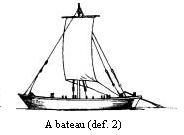Quick links
bateau
Spelling variants:batto(e)
Entry from the DCHP-1 (pre-1967)
This entry may contain outdated or offensive information, terms, and examples.
a boat such as a sloop or large rowboat.
Quotations
a flat-bottomed cargo and passenger boat about 30 feet long, tapered to bow and stern, drawing little water, and propelled by oars, poles, or a sail, originally designed for the treacherous river route between Upper and Lower Canada.
Quotations
a clumsy, flat-bottomed boat about 19 feet long between tapered ends, propelled by oars, crewed by six men, and capable of carrying about 4,000 pounds of cargo. This prototype for the York boat was widely used throughout the northwest until recent years.
Quotations
an inland freight boat, descended from the bateau, in common use from the early 1820's but used for tripping as early as 1790, and finally withdrawn from service entirely about 1930. See picture at York boat.
Quotations
Images
